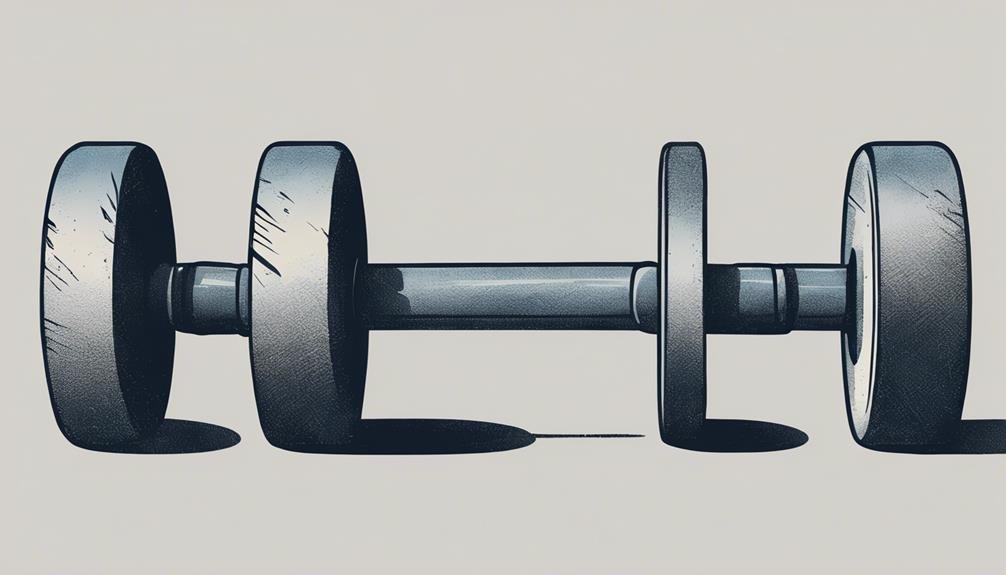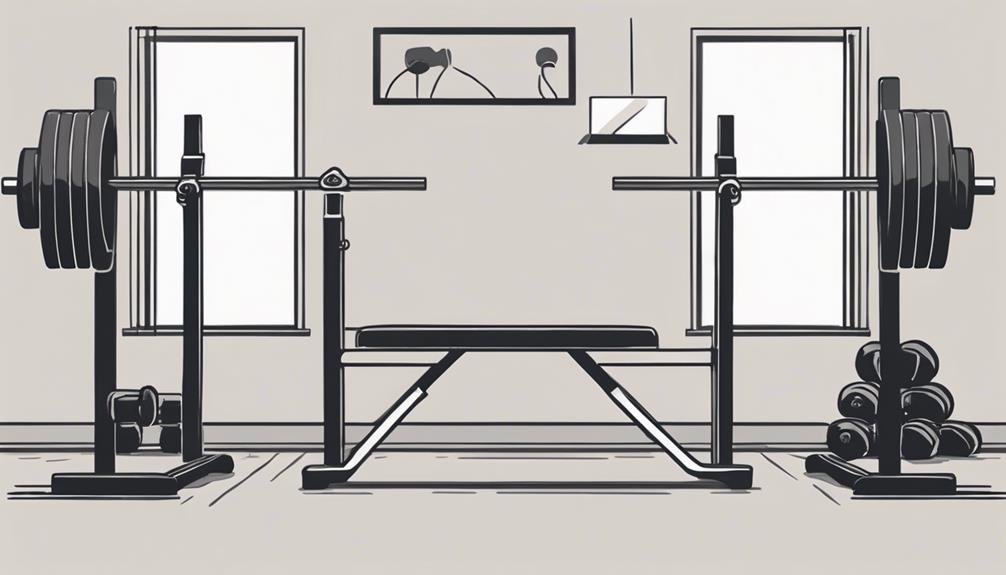What Keeps Muscles Strong After 40?
To keep your muscles strong after 40, focus on regular strength training, proper nutrition, and recovery. Aim for at least two to three sessions of resistance training each week, incorporating exercises like squats and lunges. Prioritize lean proteins, omega-3 fatty acids, and vitamins D and B12 for muscle health. Don't forget to stay hydrated and allow for recovery time to prevent fatigue and injuries. Adding flexibility exercises can also enhance your overall fitness. Consistency is key, so set clear goals and track your progress to stay motivated in your journey to maintain strength and health as you age.
Key Takeaways
- Engage in regular strength training two to three times weekly to combat muscle loss and enhance overall strength.
- Prioritize protein-rich foods and key nutrients like omega-3 fatty acids and vitamins D and B12 for muscle health.
- Incorporate flexibility exercises to improve range of motion and prevent injuries during workouts.
- Allow sufficient recovery time between workouts to support muscle rebuilding and prevent overtraining.
Importance of Muscle Strength
Muscle strength is essential for maintaining independence and overall health as you age. Strong muscles support daily activities, from lifting groceries to climbing stairs, allowing you to live life on your terms.
When you prioritize muscle strength, you enhance your balance and stability, reducing the risk of falls and injuries. This strength also plays a critical role in metabolic health, helping regulate blood sugar and improve overall energy levels.
You'll find that engaging in regular strength training not only boosts your physical capabilities but also uplifts your mood and confidence. By focusing on maintaining and building muscle strength, you're investing in your longevity, ensuring you remain active and crucial well into your later years.
Effects of Aging on Muscles

As you age, your body naturally experiences a decline in muscle mass and strength, which can impact your overall physical performance and daily activities. This process, known as sarcopenia, typically begins in your 30s and accelerates after 60.
You might notice that everyday tasks, like lifting groceries or climbing stairs, become more challenging. Additionally, hormonal changes, decreased physical activity, and nutritional deficiencies contribute to this muscle loss.
The reduction in muscle fibers and motor units can lead to slower reaction times and a higher risk of injury. Staying active and incorporating strength training into your routine can help mitigate these effects, allowing you to maintain better muscle function and overall health as you grow older.
Key Nutrients for Muscle Health
To counteract the effects of aging on muscle, focusing on key nutrients plays an essential role in maintaining strength and function.
Protein is critical; it fuels muscle repair and growth, so aim for lean sources like chicken, fish, and legumes.
Don't forget about omega-3 fatty acids, found in fatty fish and flaxseeds, which can reduce inflammation and promote muscle recovery.
Vitamins D and B12 are also important. Vitamin D helps with calcium absorption, supporting muscle contractions, while B12 is necessary for energy production.
Finally, antioxidants from fruits and vegetables protect your muscles from oxidative stress.
Incorporating these nutrients into your diet can help you stay strong and active as you age.
Prioritize these foods to support your muscle health effectively.
Classic Strength Training Techniques

Incorporating classic strength training techniques into your routine can considerably enhance your muscle strength and endurance after 40.
Focus on compound movements like squats, deadlifts, and bench presses, as they engage multiple muscle groups simultaneously. These exercises build overall strength and improve balance and coordination, essential for maintaining mobility.
Don't forget to include bodyweight exercises, such as push-ups and pull-ups, which can be scaled to your fitness level. Aim for proper form over heavy weights to prevent injury and maximize effectiveness.
Additionally, consider incorporating resistance bands or free weights to diversify your training.
Frequency and Duration of Workouts
Maintaining a consistent frequency and duration for your workouts is essential for building and preserving muscle strength after 40. Aim for at least 150 minutes of moderate aerobic activity each week, complemented by strength training sessions two to three times weekly. This balance helps stimulate muscle growth and maintain endurance.
When you structure your workouts, focus on quality rather than quantity. Shorter, more intense sessions can often be more effective than longer, less focused ones.
Consistency is key; try to schedule your workouts at the same time each week to establish a routine. Listen to your body, and adjust your duration and frequency as needed, ensuring you're challenging yourself without overexerting.
Importance of Recovery Time

Recovery time plays an essential role in ensuring your muscles rebuild and strengthen after workouts, especially as you age. When you exercise, you create tiny tears in your muscle fibers. Your body needs adequate time to repair these tears, leading to stronger muscles.
If you skip recovery, you risk overtraining, which can cause fatigue, injury, and decreased performance. Incorporating rest days into your routine allows your muscles to recover and adapt to the stress of workouts.
Aim for a mix of intense training and active recovery, such as light exercise or stretching. Listen to your body—if you're feeling sore or fatigued, it's a signal to take a break.
Prioritizing recovery is vital for maintaining strength and overall fitness as you age.
Role of Hydration in Fitness

To support your muscles during recovery and workouts, staying properly hydrated is key for peak performance and strength, especially after 40.
Water plays an essential role in muscle function, helping to transport nutrients and remove waste products. When you're dehydrated, your muscles can tire more quickly, leading to decreased strength and performance.
Aim to drink water before, during, and after exercise. If you're sweating heavily, consider electrolyte-rich drinks to replenish lost minerals.
Remember, thirst isn't always a reliable indicator of hydration; you should regularly sip water throughout the day. Additionally, incorporating water-rich foods like fruits and vegetables into your diet can further enhance your hydration levels, keeping your muscles functioning efficiently as you age.
Stay hydrated, and your muscles will thank you!
Incorporating Flexibility Exercises

Incorporating flexibility exercises into your routine can greatly enhance muscle strength and prevent injuries as you age. Stretching improves your range of motion, allowing your muscles to work more efficiently during workouts.
It's important to include both dynamic stretches before your workouts and static stretches afterward. Aim for at least 10-15 minutes of stretching, focusing on major muscle groups like your hamstrings, quadriceps, and shoulders.
Yoga and Pilates are excellent options that combine flexibility with strength-building. Additionally, listen to your body; if you feel tightness or discomfort, take time to stretch those areas more.
Tracking Progress and Goals

Regularly tracking your progress and setting specific goals can greatly enhance your muscle strength as you age. By keeping a record of your workouts, you'll see what works and what doesn't. This awareness helps you adjust your routine effectively.
You can establish clear, attainable goals to motivate yourself. Here's a simple way to organize your tracking:
| Goal | Progress Tracking |
|---|---|
| Increase weight lifted | Weekly weight log |
| Improve endurance | Track time or reps |
| Enhance flexibility | Record stretch duration |
Using this method, you'll stay accountable and focused on your fitness journey. Celebrate small victories along the way, and don't hesitate to adjust your goals as you progress!
Questions
Can Genetics Influence Muscle Strength After Age 40?
Yes, genetics can influence muscle strength as you age. Some people naturally have a genetic advantage for muscle growth and recovery, while others may face challenges. However, lifestyle choices also play a significant role in maintaining strength.
Are There Specific Exercises for Joint Health?
Yes, certain exercises can enhance joint health. Focus on low-impact activities like swimming, cycling, and yoga. These improve flexibility, strengthen surrounding muscles, and reduce stress on your joints, promoting overall mobility and well-being.
How Does Sleep Quality Affect Muscle Recovery?
Sleep quality greatly impacts muscle recovery. When you sleep well, your body repairs and rebuilds muscle tissue efficiently, leading to better strength and performance. Prioritize restful sleep to enhance your recovery and overall fitness.
What Role Do Hormones Play in Muscle Maintenance?
Hormones are like silent partners in your muscle journey. They help regulate growth, repair, and overall strength. As you engage in regular activity, these hormonal allies work hard to keep your muscles feeling fantastic.
Can Stress Impact Muscle Strength in Older Adults?
Yes, stress can impact your muscle strength. When you're stressed, your body releases cortisol, which can lead to muscle breakdown and hinder recovery. Managing stress through relaxation techniques can help maintain your strength and overall well-being.
Conclusion
Staying strong after 40 isn't just possible; it's essential for your overall well-being. You might think it's too late to make a difference, but every small effort counts.
By focusing on strength training, proper nutrition, and recovery, you can revitalize your muscles and boost your energy. Don't underestimate the power of hydration and flexibility exercises, either.
Embrace this journey, set achievable goals, and watch your strength flourish—it's never too late to invest in yourself!







